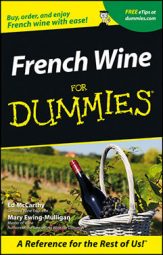France produces more wine than any other country — except when Italy does. (The two countries are neck and neck.) The amount of wine produced varies from one year to the next, according to the weather. Generally speaking, France makes about 1.5 billion gallons of wine each year.
Luckily for the reputation of French wines, the huge quantity produced each year comprises hundreds of different types of wine. Variety, in fact, is the rule for French wines:
French wines are white, red, and pink.
French wines are still (non-bubbly) wines and bubbly wines.
French wines are dry wines, semi-dry wines, and sweet wines.
French wines sell for less than $8 a bottle and for several thousand dollars a bottle.
French wines are simple wines for enjoying while they’re young, and serious wines that aren’t at their best until they age for a few decades.
French wines are hand-crafted artisan wines made by small family wineries and mass-production wines made by large corporations.
France produces more red wine than white or rosé (pink) wine. Rosé wines are made throughout France, and some of them are quite special, but they represent just a tiny part of the country’s production.
France's dry, sweet, and bubbly wines
French wines are predominantly dry, non-sparkling wines. Sparkling wines represent less than 10 percent of France’s production. Champagne itself — the major sparkling wine of France (and the world) — accounted for about 5.5 percent of French wine production in 1999. Many other regions also make sparkling wine, but in significantly smaller quantity than Champagne.
Almost every region of France makes some type of sweet, dessert wine, but no one region specializes in it. The quantity varies quite a lot from year to year because sweet wine production often depends on specific weather patterns that don’t visit a region predictably each year. Sauternes are probably the world’s most revered type of sweet wine in the eyes of serious wine collectors.
Collectable to highly affordable
France’s finest wines enjoy the highest reputation of any wines anywhere. The best wines of the Champagne, Bordeaux, Burgundy, and Rhône regions dominate the cellars of the world’s most celebrated wine collectors, as well as the auctions where rare wines are bought and sold. Bottles of mature wines can cost thousands of dollars each, depending on the wine and the vintage.
But France makes plenty of mid-range and inexpensive wines, too. In just about any good wine shop in the U.S., you can find wines from southern France that sell for as little as $6 a bottle — good, everyday wines for casual enjoyment. Between the least expensive and the most precious French offerings are the majority of French wines — high quality wines that cost from about $15 to $35 and are suitable either for drinking young or for aging a few years.
France's regional characters
Wineries in different parts of France cultivate different grape varieties and make their wines in different ways. Even when two regions grow the same grape variety, their wines usually turn out to be distinctly different, because of terroir differences, or different winemaking traditions. The Sauvignon Blanc variety provides a good example of how the same grape makes different wines:
In the Loire Valley, it makes crisp, un-oaked wines with well-concentrated, minerally flavors.
In the Bordeaux region, winemakers frequently blend Sauvignon Blanc wine with Sémillon, making a fleshier, longer lasting wine with more subtle flavors; often, they use oak barrels, which give the wine a smoky or toasty character.
In the south of France, Sauvignon Blanc wines have riper fruit flavors than those from either the Loire or Bordeaux.

